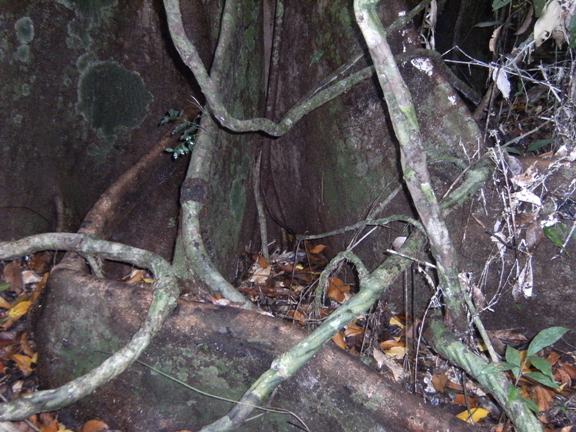Plant roots don’t just grow down under the soil surface. A few posts back I wrote about the aerial roots of strangler figs: beginning as thin hair-like structures, they thicken into strong cables & eventually their interlaced networks engult the trunk of the hapless host tree. Then there are the pneumatophores of mangroves and bald cypresses, their pores & air-filled internal spaces allowing the tree roots to obtain oxygen directly from the air (an adaptation to life in anoxic soils). And of course, there are buttress roots.
If you’re familiar with NZ trees, you may have seen pukatea, with its ‘plank buttresses’: thin flap-like extensions that rise up from the roots & extend up the base of the stem. We saw very similar buttress roots in the Daintree rainforests:

You can see from this picture how high these buttresses rise above the ground – there’s one behind me & others to the right of the image. (According to wikipedia they can be nearly 5m high in some specimens, so my tree is just a tiddler really!) Many tropical trees have similar structures: they’re most commonly seen in swamp-growing plants. In mature trees these roots may be asymmetrically distributed around the trunk & longer on the side facing into the prevailing wind (those on the leeward side tend to be taller). That would be an interesting subject for a field study!! You’ll see similar structures in gothic cathedrals – the following photo shows the soaring arch of a flying buttress on Notre Dame cathedral in Paris. These elegant structures help to support the weight of imposing mediaeval buildings, allowing architects to build higher while decreasing the odds of a catastropic collapse as the building’s mass increased.
 The usual view of buttress roots is that they function in the same way, providing additional support for the tree – something which would be particularly useful in the sodden soils of swamps. I’ve heard it said that the buttress roots of plants inspired medieval architects to design their own soaring supprt arches. (But then, most buttress-forming trees go in the tropics, & few mediaeval architects would have made it so far south… Perhaps this tale of life imitating art is a case of a nice just-so story?) Anyway, reading about the Daintree after our visit, I saw the suggestion that the roots don’t act in this way (& – anecdotally! – our guide, Ross, commented that he often saw fallen trees whose buttress roots had not supported them particularly well). Instead, the guide book said, the curving flanges of the roots channel nutrients into the area around the tree, preventing valuable minerals and other materials from being washed away in heavy rain. You can see those curving structures here:
The usual view of buttress roots is that they function in the same way, providing additional support for the tree – something which would be particularly useful in the sodden soils of swamps. I’ve heard it said that the buttress roots of plants inspired medieval architects to design their own soaring supprt arches. (But then, most buttress-forming trees go in the tropics, & few mediaeval architects would have made it so far south… Perhaps this tale of life imitating art is a case of a nice just-so story?) Anyway, reading about the Daintree after our visit, I saw the suggestion that the roots don’t act in this way (& – anecdotally! – our guide, Ross, commented that he often saw fallen trees whose buttress roots had not supported them particularly well). Instead, the guide book said, the curving flanges of the roots channel nutrients into the area around the tree, preventing valuable minerals and other materials from being washed away in heavy rain. You can see those curving structures here:
 So which is the more likely explanation? A 1999 paper examined the function of these specialised roots, comparing how effective buttressed & non-buttressed roots were at anchoring tropical trees (Crook, Ennos & Banks, 1999). These authors commented that buttress roots had ‘sinker’ roots extending downwards into the soil from the ends of the buttresses, something that ‘non-buttress’ trees didn’t have (although both types of tree had tap roots). In anchorage tests, where the trees were subjected to lateral forces, the buttressed trees performed much better, being considerably less likely to be overthrown. (My engineering colleagues would say that the buttress roots function as ‘tension & compression members’.) So that strongly supports the ‘usual’ view.
So which is the more likely explanation? A 1999 paper examined the function of these specialised roots, comparing how effective buttressed & non-buttressed roots were at anchoring tropical trees (Crook, Ennos & Banks, 1999). These authors commented that buttress roots had ‘sinker’ roots extending downwards into the soil from the ends of the buttresses, something that ‘non-buttress’ trees didn’t have (although both types of tree had tap roots). In anchorage tests, where the trees were subjected to lateral forces, the buttressed trees performed much better, being considerably less likely to be overthrown. (My engineering colleagues would say that the buttress roots function as ‘tension & compression members’.) So that strongly supports the ‘usual’ view.
But the idea that explanation might be ‘better’ than another could well be a false dichotomy: the roots could well serve both functions. (As my friend Rose has said, we do tend to go for single, simple, reductionist explanations, and this is a pity because it can divert us from the beauty of a fuller, more complex situation.) Rainforest soils are often thin & surprisingly low in nutrients: forest trees put out shallow, lateral ‘feeder’ roots to garner as many nutrients as possible. As that last photo shows, curving buttress roots hold fallen leaves & other debris close to the tree. It had rained heavily the night before we went into the forest & you could see in places how materials had washed down & become trapped in the network of above-surface roots, which would surely tend to maximise the plant’s ability to obtain the nutrients it needs.
One structure, at least two functions, both advantageous to the tree & so likely to have been strongly selected for. The simplest, single explanation may not always be the full story 🙂
M.J.Crook, A.R.Ennos & R.Banks (1999) The function of buttress roots: a comparative study of the anchorage systems of buttressed (Aglaia and Nephelium ramboutan species) and non-buttressed (Mallotus wrayi) tropical trees. Journal of Experimental Botany 48(9):1703-1716
ravendell says:
nice blog and I really love the place…
vedere parigi